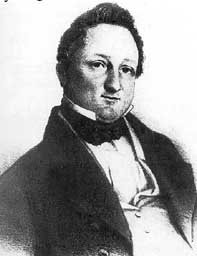Franz von Winckler
Franz von Winckler (actually Franciscus Winckler , since 1840 von Winckler ; born August 4, 1803 in Tarnau , district of Frankenstein (Silesia) ; † August 6, 1851 ) was a German mining entrepreneur in Upper Silesia . The development of Katowice to an industrial city is largely due to him.

Life
Franz von Winckler began his successful career in 1818 as a miner in an ore mine in Upper Silesia. His talents were noticed and, with the support of the royal mining authority, he attended the mountain school in Tarnowitz from 1821 until it was closed after the director's death. He then worked as a shift manager at the Maria Galmei mine near Miechowitz near Beuthen . Its owner, Franz Freiherr von Aresin , made him mine manager soon afterwards. After his employer died a short time later, Winckler became indispensable for the heirs. Winckler's first marriage was to Alvine Kalide , the sister of the sculptor Theodor Kalide (1801–1863), who was born in Upper Silesia and lived in Berlin . Winckler also commissioned his brother-in-law Theodor , the aspiring artist at the Berlin School of Sculpture , who was interested in the rich furnishings of his property, for a marble sculpture, a bacchante on a panther.
After Alvine's death in 1829, Winckler married the widow of his late employer, Maria Baroness von Aresin , in 1832 . As a result, the properties and companies that he had already managed came directly into his hands. Especially after a study trip to England, Winckler expanded the industrial operations. In the years 1838 and 1839, the Wincklers acquired the manors Kattowitz and Myslowitz in addition to Miechowitz .
As a mine and ironworks owner and landlord on Miechowitz, Winckler was appointed by A.KO. Elevated to the Prussian nobility on October 15, 1840 in Berlin with a diploma from September 6, 1854 in Putbus .
The couple won the Bergregal through various processes . The mountain police were ultimately in the hands of the Winckler family until they renounced it in 1898. Without significant government intervention, Winckler was able to mine his property. An advantage for him was that Kattowitz was connected to the railroad network as early as 1846, thanks to Winckler's decisive commitment.
Winckler eventually had eight estates with considerable land holdings, various industrial companies, ore mines, and important coal mines. He also owned 14 calamine pits and 69 hard coal fields. The iron ore mines were so productive that they were able to meet the raw material requirements of the five ironworks built between 1836 and 1838 until the 1860s. There were also seven zinc smelters. The share of zinc smelters in Upper Silesian zinc smelting production was 19.1% in 1853. The company produced 110,000 quintals of zinc, 100,000 quintals of pig iron and 40,000 quintals of wrought iron. He employed about 4,000 workers and employees.
Along with the Hohenlohe , Henckel von Donnersmarck , Schaffgotsch and Ballestrem families , he was one of the most important mining magnates in Upper Silesia. A long-time colleague and friend was Friedrich Wilhelm Grundmann , who kept this position after his and his wife's death under the heiress Valeska von Winckler . The daughter eventually married Lieutenant Hubert von Tiele (1823-1893). That is why the family has been called Tiele-Winckler ever since . The descendants founded the Franz von Winckler Foundation (planned by him) as early as 1852 to support miners and smelters. The widow inherited the property; after that it fell to the daughter Valeska.
Due to the support of the brother-in-law Theodor Kalide , the execution of the grave monument for Winkler was entrusted to him, which was carried out in 1853 (but has now completely disappeared).
Through the activities of Winckler and his heirs, Kattowitz developed from a village with 1846 1326 inhabitants to an industrial settlement and an important location for trade, transport and administration. The place received city rights in 1865.
literature
- Toni Pierenkemper: Entrepreneur aristocrats in Silesia . In: Elisabeth Fehrenbach (Hrsg.): Nobility and bourgeoisie in Germany 1770–1848. Munich, 1994 ISBN 3-486-56027-1 p. 153f.
- Klemens Skibicki: Industry in the Upper Silesian Principality of Pless in the 18th and 19th centuries . Stuttgart, 2002 ISBN 3-515-08036-8 pp. 235f.
- Gothaisches genealogisches Taschenbuch der Briefadeligen houses, 1917, eleventh year, p.957
Individual evidence
- ↑ Elisabeth Fehrenbach, Elisabeth Müller-Luckner: Nobility and Bourgeoisie in Germany 1770-1848 , 1994, page 154 ( digitized version )
- ^ Genealogisches Handbuch des Adels , Adelslexikon Volume XVI, page 243, Volume 137 of the complete series. CA Starke Verlag, Limburg (Lahn) 2005, ISBN 3-7980-0837-X
| personal data | |
|---|---|
| SURNAME | Winckler, Franz von |
| BRIEF DESCRIPTION | German coal and steel industrialist |
| DATE OF BIRTH | 4th August 1803 |
| PLACE OF BIRTH | Tarnau |
| DATE OF DEATH | August 6, 1851 |
